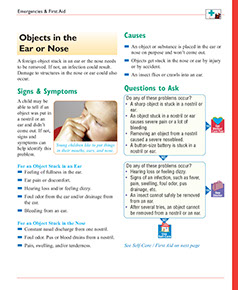CONDITIONS
SYMPTOM CHECKER
Male
Female
Child
Arm, Hand & Shoulder Concerns
Legs & Feet Concerns
Dental & Mouth Concerns
Ear & Nose
Eye Conditions
Head Conditions
Arm, Hand & Shoulder Concerns
Legs & Feet Concerns
Front
Back
Arm, Hand & Shoulder Concerns
Dental & Mouth Concerns
Ear & Nose
Eye Conditions
Head Conditions
Arm, Hand & Shoulder Concerns
Dental & Mouth Concerns
Ear & Nose
Eye Conditions
Head Conditions
Front
Back
Arm, Hand & Shoulder Concerns
Neck Links
Head & Neck Concerns
Arm, Hand & Shoulder Concerns
Neck Links
Head & Neck Concerns
Front
Back
Online Clinic
Wise Healthcare
Objects in the Ear or Nose
A foreign object stuck in an ear or the nose needs to be removed. If not, an infection could result. Damage to structures in the nose or ear could also occur.
Signs & Symptoms
A child may be able to tell if an object was put in a nostril or an ear and didn’t come out. If not, signs and symptoms can help identify this problem.
Bites & Stings
For an Object Stuck in an Ear
• Feeling of fullness in the ear.
• Ear pain or discomfort.
• Hearing loss and/or feeling dizzy.
• Foul odor from the ear and/or drainage from the ear.
• Bleeding from an ear.
For an Object Stuck in the Nose
• Constant nasal discharge from one nostril.
• Foul odor. Pus or blood drains from a nostril.
• Pain, swelling, and/or tenderness.
Causes
• An object or substance is placed in the ear or nose on purpose and won’t come out.
• Objects get stuck in the nose or ear by injury or by accident.
• An insect flies or crawls into an ear.
Treatment
Medical care is needed for foreign objects that can’t be removed with self-care. After an object is removed, an antibiotic may be needed if an infection is present. Small, button-sized batteries need to be removed to prevent burns.
Questions to Ask
Question 1
Do any of these problems occur?
• A sharp object is stuck in a nostril or ear.
• An object stuck in a nostril or ear causes severe pain or a lot of bleeding.
• Removing an object from a nostril caused a severe nosebleed.
• A button-size battery is stuck in a nostril or ear.
Get medical care without delay. If symptoms are life threatening go to the ER or call 9-1-1. Don’t call 9-1-1 or use the ER if symptoms do not threaten life. Ask your doctor ahead of time where you should go for a problem that needs prompt care, but not emergency care.
Question 2
Do any of these problems occur?
• Hearing loss or feeling dizzy.
• Signs of an infection, such as fever, pain, swelling, foul odor, pus drainage, etc.
• An insect cannot safely be removed from an ear.
• After several tries, an object cannot be removed from a nostril or an ear.
You should be seen by your doctor for medical advice. Contact your doctor or health care provider to find out how soon you should be seen.
Use Self-Care / First Aid:
You can probably take care of the problem yourself if you answered NO to all the questions. Use the “Self-Care” measures that are listed. Call your doctor if you don’t feel better soon, though. You may have some other problem.
Self-Care / First Aid
To Remove an Insect from an Ear
• Kill the insect before you try to remove it. To do this, tilt the person’s head to put the ear with the insect in an upward position. Pour warm (not hot) mineral, olive, or baby oil into the ear. As you pour the oil, straighten the ear canal. In a child, pull the earlobe gently backward and downward; backward and upward in an adult.
• The goal is to suffocate the insect and cause it to float out.
To Remove Objects Other Than Insects
• Don’t use oil.
• Tilt the head toward the side with the foreign object. Gently shake the head toward the floor to try to get the object out. Do not shake a baby. Gently pull the ear up and back.
• Don’t use a sharp tool, cotton swab, etc., to try to locate and remove the object. This risks pushing the object farther into the ear. Doing this could damage the middle ear.
• Remove the object with blunt tweezers if it is easily seen and can be grasped and pulled out.
To Remove Objects in the Nose
• Don’t use a sharp tool, cotton swab, etc., to try to locate and remove the object.
• Breathe through the mouth until the object is removed.
• Apply gentle pressure to close the other nostril and gently try to blow the object out.
• Remove the object with blunt tweezers, if it is easily seen and can be grasped and pulled out.
This website is not meant to substitute for expert medical advice or treatment. Follow your doctor’s or health care provider’s advice if it differs from what is given in this guide.
The American Institute for Preventive Medicine (AIPM) is not responsible for the availability or content of external sites, nor does AIPM endorse them. Also, it is the responsibility of the user to examine the copyright and licensing restrictions of external pages and to secure all necessary permission.
The content on this website is proprietary. You may not modify, copy, reproduce, republish, upload, post, transmit, or distribute, in any manner, the material on the website without the written permission of AIPM.
2021 © American Institute for Preventive Medicine - All Rights Reserved. Disclaimer | www.HealthyLife.com
















































